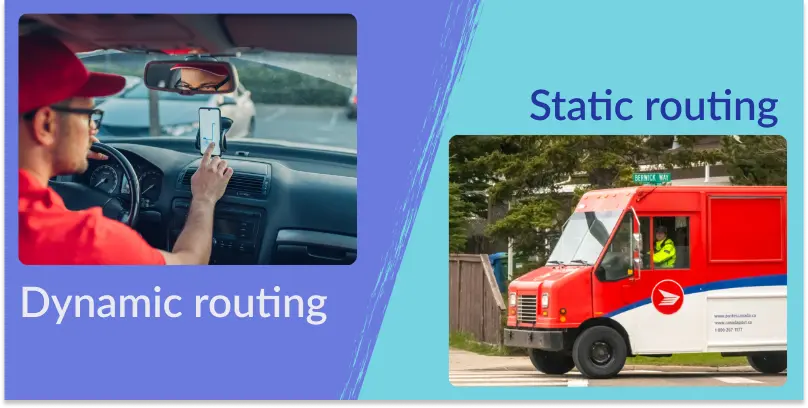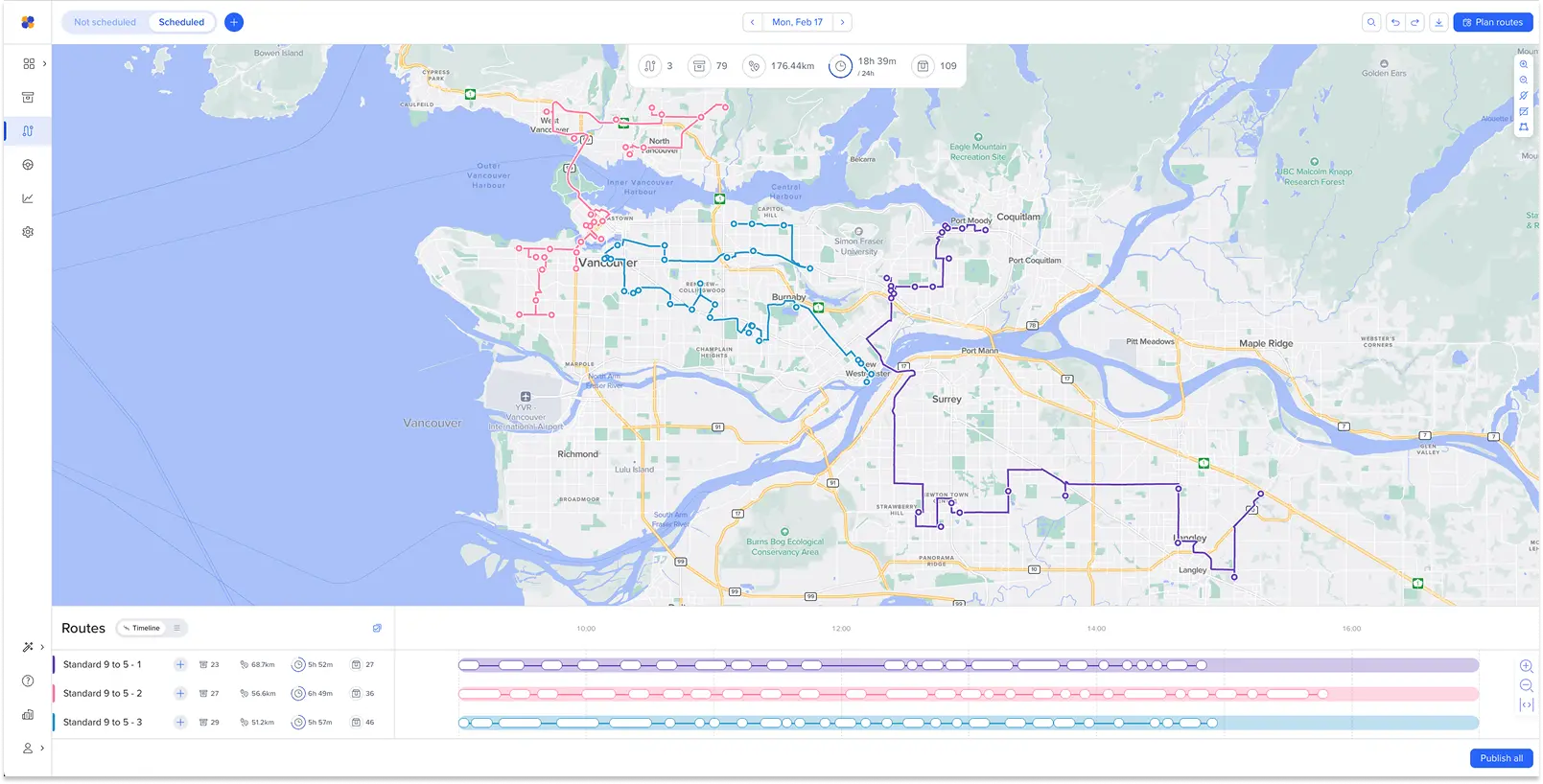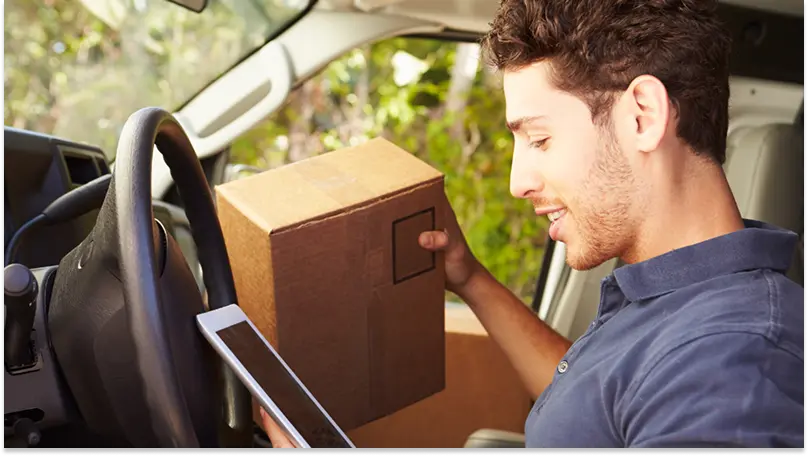Dynamic Route Optimization: Beyond the Buzzwords

Vendors promise “dynamic AI-powered routing” — but what does that actually mean? We break down the buzzwords and show you what really matters.

- Dynamic route optimization simply means software that can adjust routes when conditions change — new orders, cancellations, or missed deliveries. It's not as complex as vendors make it sound.
- Most delivery businesses need daily route planning, not continuous optimization. Once drivers are loaded and on the road, major route changes become impractical anyway.
- "Continuous optimization" is mostly marketing hype. Only mega-enterprises like UPS and Amazon have built true continuous systems — and they cost millions to develop and maintain.
- Route quality matters. There’s a difference between a mathematically optimal route, and a route that works in the real world. Good route optimization creates logical routes that drivers actually want to follow, not “spaghetti routes” that zigzag across delivery areas.
- Focus on practical features over buzzwords. Easy order import, simple route adjustments, reliable driver apps, and automated customer notifications deliver real-world value.
- Match the software to your actual needs. A bakery planning routes once daily has different requirements than a courier service handling same-day pickups. Pick the software that offers capabilities you'll use often.
If you’re looking for delivery route planning software, you’ve probably read about "dynamic route optimization”, “continuous optimization”, or “real-time AI-powered routing”. It all sounds very impressive — but what do these terms actually mean, beyond marketing fluff?
Fortunately, it’s a lot simpler than it looks. Dynamic routing just means using software that can adjust routes when things change — for example when new orders come in, a driver gets delayed by traffic congestion, or a customer cancels last-minute. The question isn't whether you need dynamic route optimization, it’s what level of route planning flexibility your business actually needs.
Let’s unpack what dynamic route optimization actually means in practice.
Static vs. dynamic routing: What's the difference?
Route optimization just means finding the best route to complete a set of deliveries — usually the shortest or fastest route that hits all your stops. There are two main approaches: static and dynamic.
Static route planning means you plan an optimal route once, then repeat it without changes. This works well for predictable schedules like:
- Mail delivery
- Daily milk routes
- School bus schedules
Static routes are efficient but rigid. Given enough advance notice, it’s relatively easy to add or remove a stop or two as orders change. But static routing breaks down when unexpected things happen — road closures, adverse weather conditions, or order changes. When that happens, drivers and dispatchers have to improvise manually.
Dynamic route optimization software uses algorithms, often enhanced by machine learning, to handle changing conditions. Here are three common scenarios:
- A bakery takes online orders and delivers fresh goods. Each day brings different orders, so they need fresh routes planned every morning.
- A courier service handles same-day pickups and deliveries. New orders come in throughout the day, so they need to reassign drivers and make real-time route adjustments.
- A repair company schedules maintenance calls but also handles emergencies. Their daily schedules need flexibility for urgent jobs that pop up.
Each type of business needs different levels of flexibility. For example, the bakery can probably plan all its routes for the day in advance, just in time to assign drivers and load up its delivery vehicles. Changes during delivery hours will be rare. On the other hand, the courier service will need constant adjustments as new pickups come in. The repair company falls somewhere in between — mostly pre-scheduled routes, with room for urgent calls.

When it comes to choosing software, the key is understanding what level of dynamic planning actually helps your operation, rather than paying for features you'll never use.
Three types of dynamic route optimization
When vendors talk about dynamic route planning they usually mean one of three things. Understanding the difference can save you from overpaying for capabilities you don't need.
1. Daily delivery scheduling

This is a common scenario for businesses, like our bakery example, that offer last mile delivery services: Planning fresh delivery routes for each day, based on that day's orders and conditions. You upload your orders, the route optimization software plans the most efficient routes, and drivers follow them.
Nowadays, most route optimization software also offers additional delivery management features like:
- A mobile driver app with real-time tracking, so dispatchers can easily send routes to drivers and monitor their progress throughout the day.
- Notifications to let customer know when to expect their deliveries, and track their drivers as they approach.
- Proof of delivery features like signatures and photos.
Best for: Businesses with different orders every day but predictable delivery time windows (like meal kit companies or farm-to-door services).
Reality check: This level of adaptability is what most small delivery businesses actually need. Once drivers are loaded and on the road, major route changes are impractical.
2. Real-time route adjustments
In scenarios like same-day pickup and delivery, businesses need dynamic routing software that can handle new requests during delivery hours. These kinds of real-time adjustments are important for courier services and businesses that deliver rush orders, as well as for some service businesses.
This kind of software typically includes:
- Dynamic driver assignment, based on location and capacity.
- Real-time route recalculation when new orders come in.
- Integration with order management systems for instant pickup requests.
- Load optimization features to maximize vehicle capacity.
- Emergency dispatch capabilities for urgent jobs.
Best for: Courier services, food delivery, or field service companies handling emergency calls (like HVAC repair or medical equipment).
Reality check: This level of dynamic route planning is essential for delivery operations that promise same-day pickup and delivery, but requires solid driver communication systems.
3. Continuous optimization
Continuous route optimization involves routes that are constantly recalculated based on real-time data — traffic, GPS locations of drivers, new orders streaming in.
True continuous route optimization is very rare. UPS's ORION system introduced dynamic routing in 2021, for example, and Amazon’s Condor algorithm adjusts delivery options continuously until an order is actually loaded onto a truck for delivery. These are massive custom-built enterprise systems that run on specialized hardware, have full-time development teams, and cost millions to develop and maintain. They’re not software packages anyone can buy.
Best for: Mega-enterprises with tens of thousands of daily routes and the technical and financial resources to build custom optimization systems.
Reality check: If you're not delivering 100,000+ packages daily, you don't need what UPS and Amazon built. Most "continuous optimization" claims from routing software vendors are marketing hype. What small businesses actually need is reliable daily route planning with the ability to make manual adjustments when things go wrong.
Route optimization for real businesses
Most delivery businesses can benefit most from daily delivery scheduling, with some capacity for real-time adjustments. Here's what to look for and what benefits you can actually expect.

The benefits of route optimization
1. Time savings
Manual route planning can take hours every day. Route optimization can cut that to a few minutes, with the software doing most of the work. Automation can make things even faster, for example by using APIs to fetch order information directly from e-commerce management systems into the route planner.
2. Cost savings
Optimized routes are on average 10-20% shorter. Less distance driven means lower fuel consumption and less wear and tear on vehicles, which translates directly into lower operational costs and higher profitability.
3. Customer satisfaction
Vague delivery times and late deliveries make for a poor customer experience. Route optimization and delivery management software offers a range of features to improve customer satisfaction: Accurate ETAs, a choice of delivery time windows, and real-time tracking notifications.
4. Driver satisfaction
Experienced delivery drivers can enable a more efficient delivery operation, with evidence showing drivers can be 10% faster on routes they know well. Add that to the stress and disruptions caused by high driver turnover, and there’s definite value in delivery management software that can make drivers’ lives easier. Accurate ETAs lead to more predictable shift times, and automated customer notifications with real-time updates result in fewer awkward interactions with unhappy customers.
5. Increased sustainability
Inefficient logistics operations are expensive for businesses, and also for the environment. When route planning software reduces fuel costs and vehicle wear and tear, it also reduces emissions. Even for EV fleets that have zero carbon emissions, particulate emissions from brakes and tyres can be a source of pollution. The bottom line: Any routing solution that reduces distance driven is a net benefit to the environment.
Features to look for in dynamic route optimization software
Route optimization software has developed rapidly over the past decade. Automated customer notifications, for example, may have been functionality worth writing home about about ten years ago — now it’s a baseline expectation.

1. Easy order import from existing systems
Look for software that can automatically pull orders from your e-commerce platform, CRM, or order management system. API integrations with platforms like Shopify, WooCommerce, or custom systems save time, eliminate manual data entry, and reduce errors.
Ensure you can import all the information you need to streamline your delivery process — not just orders and addresses, but also delivery preferences, time windows, and special instructions.
2. Route quality
Not all route optimization algorithms are created equal. Poor routing software can create “spaghetti routes” — paths that are mathematically efficient, but make drivers zigzag across their delivery area instead of following sequences that make sense to humans. These criss-crossing routes frustrate drivers and waste time in practice.
The best route optimization software considers real-world constraints that affect route quality. These include traffic conditions throughout the day, vehicle restrictions like weight limits or height clearances, and driver preferences for familiar areas. The best algorithms also account for practical factors like the difficulty of left turns in heavy traffic, delivery time windows, and the time it actually takes to complete each stop (not just travel time).
Driver acceptance is a crucial test of route quality. Experienced drivers often know shortcuts and traffic patterns that basic algorithms miss. If your drivers frequently ignore the suggested routes or constantly request changes, that's a red flag about your optimization quality. Look for software that learns from driver behavior and incorporates local knowledge, rather than rigidly insisting on routes that don't work in practice.
A good route should feel logical to both dispatchers and drivers — flowing naturally through neighborhoods and respecting real-world driving patterns rather than creating confusing, inefficient paths that waste time and fuel.
3. Easy route adjustments
Most businesses don’t need Amazon-level software that adjusts routes automatically as every new order comes in — but you do need some ability to make changes. Sometimes the optimization solution isn’t perfect, and you want to move one or more deliveries to a different route. At other times you may need to add a last-minute order or cancel an existing order.
Your software should make it easy to add last-minute orders, remove cancelled deliveries, or handle failed delivery attempts without rebuilding entire routes from scratch. Look for drag-and-drop route editing, automatic re-optimization when stops are added or removed, and the ability to reassign deliveries between drivers quickly when circumstances change.
4. Mobile driver apps that update automatically when routes change

Your drivers need more than just a list of addresses, and free mobile apps are now standard with most route optimization software. A good driver app provides turn-by-turn navigation, shows the optimized stop sequence, and updates instantly when you make route changes from the dispatch center. Look for apps that work offline (for areas with poor cell coverage), allow drivers to mark deliveries complete, and capture proof of delivery without switching between multiple apps.
5. Customer notifications with tracking and delivery windows
Automated customer communications reduce the burden on your customer service team and improve satisfaction. The software should send notifications when drivers are dispatched, provide accurate delivery ETAs (not just “between 9 AM and 5 PM”), and offer real-time tracking links so customers can see their driver's progress. Look for customizable messaging that matches your brand voice and supports multiple communication channels like SMS, email, or push notifications.
6. Proof of delivery built into the driver workflow
Signatures, photos, and delivery confirmations should be captured seamlessly within the driver app, not as an afterthought. The best systems automatically timestamp and GPS-tag proof of delivery, store it securely in the cloud, and make it instantly accessible to dispatchers and customer service teams. This protects your business from delivery disputes and provides customers with immediate confirmation that their order arrived.
7. Scalability
Many businesses start with a handful of daily deliveries but eventually expand to multiple drivers, vehicles, and service areas. So if you plan for your business to grow, look for software that can scale with it.
Here are some specific scalability questions to ask:
- How do the pricing tiers work? Some route optimization software providers charge per stop or order; other charge per driver or vehicle. Check where the pricing changes, and what the maximum limits are.
- How flexible is their user management? As you grow, you'll likely need to add dispatchers, give different team members different levels of access.
- Do they support multiple locations? Many successful delivery businesses eventually expand to multiple service areas or distribution centers. If that's in your future, check whether your software can handle multiple depots, different service zones, or even separate business units from a single dashboard.
- What API and integration capabilities do they offer? As your delivery operations grown you may need to integrate with new systems like warehouse management or customer service platforms. Look for software with robust APIs and a track record of integrating with the tools you use or plan to use.
The goal is finding software that can handle both your current 50 deliveries per day and your future 500 deliveries per day without requiring a complete system overhaul when you're at your busiest.
Frequently Asked Questions
Related articles
Liked this article? See below for more recommended reading!

12 Great Delivery Business Ideas For 2025

8 Practical Ways To Improve Delivery Efficiency


